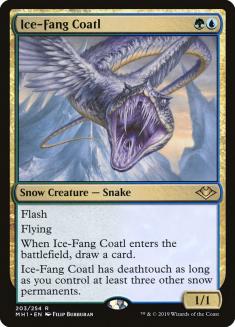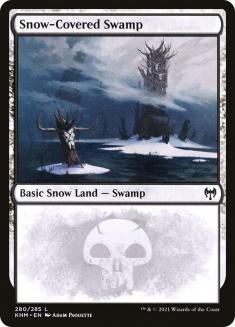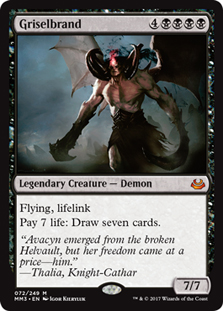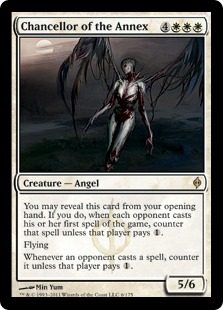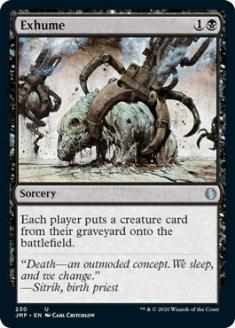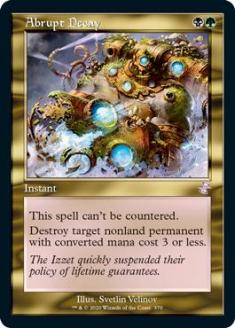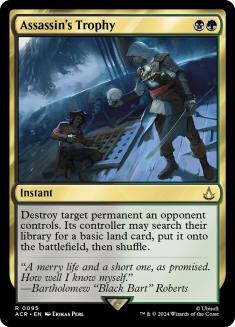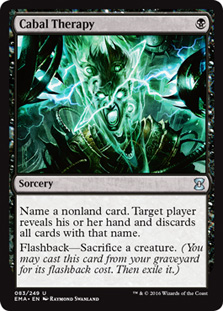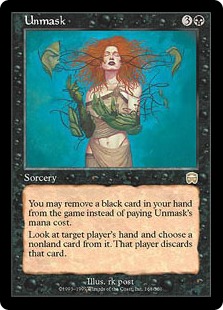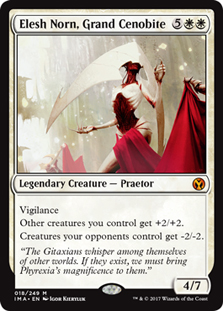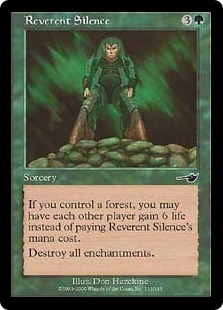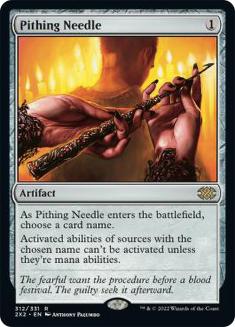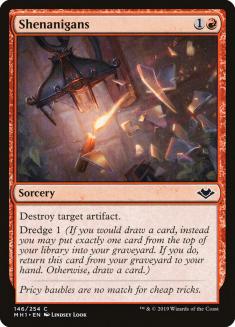I have a weird relationship with playing Magic these days. My contract with Play Design precludes me from playing in tournaments with a significant prize — not that I was playing in these events frequently anyway. I find it useful for the work to dabble in all the Constructed formats and Magic Online (MTGO) Leagues have a top prize of about $35, so Big Dan Teague is fairly active across the board. Even though the prizes are relatively modest, every ticket on my account signifies some dollar I wrested from someone else, and each of those represents a trophy more significant than any from my physical playing days, all of which are literally in the trash now anyway.
Legacy has always been the toughest format for me to dabble in. My pet deck, Burn, has always been wildly unplayable, subsidized by a relatively friendly, combo-light paper metagame plus general incompetence from the aggregate opponent. The format is broadly more powerful than it was five or ten years ago, and I’ve found the MTGO metagame to be more stocked with combo and Chalice of the Void decks than what I found in physical play.
Spells (28)
- 4 Lightning Bolt
- 4 Fireblast
- 4 Chain Lightning
- 4 Lava Spike
- 4 Rift Bolt
- 4 Exquisite Firecraft
- 4 Skewer the Critics
Sideboard

The above is the Burn list of someone who has been shellacked by every manner of combo deck. Zero cards for Delver, four copies of a legendary land that essentially doesn’t make mana. “Well, with the London Mulligan…” I’d tell myself en route to another 2-3. This was neither mentally nor economically sustainable.
Of all the busted cards available in Legacy, my favorite is Lotus Petal. Dark Ritual is a close second. Holding priority remains elusive for me on MTGO, and so with Storm out of the question, that left Reanimator. After grinding together the roughly 400-ticket buyin for the deck by working my Boros Charms down to a nub (“working the package,” as I like to call it), I copied a preliminary winning list, which I quickly discarded. After months of iteration, I’ve finally settled on a list I like, with a League win rate such that I’d play it in a major event, were I permitted to play in one.
Creatures (7)
Lands (15)
Spells (38)

The Mana
Yes, the Swamps should be Snow-Covered. It isn’t just for bluffing — I did play a game during which I used Reanimate on an opposing Ice-Fang Coatl, and then lost the game because it didn’t have deathtouch. I’d rather lose one game out of a thousand this way than give up my preferred art, but your mileage my vary.
It’s important to split the fetchlands, even though every mana-producing land is a Swamp. People regularly bring in Surgical Extraction, Pithing Needle, and Sorcerous Spyglass against you, and so it can be very punishing to draw multiple copies of the same fetchland.
Reanimation Targets
Griselbrand is the star of the show.
It’s good enough to beat most honest decks by itself, and if it goes uncontested, it’s usually easy to chain together multiple discard spells and another reanimation target in the same or following turn. Iona is a lock or close to it against a number of strategies, and Tidespout Tyrant can work you around problematic permanents; being nonlegendary is a key for beating Karakas in Game 1, along with other soft-lock permanents like Ensnaring Bridge. That slot initially was Ashen Rider, but a lot of the decks that play Karakas (Lands, Death and Taxes) also produce other troublesome cards like Oko, Thief of Crowns, or just multiple copies of Karakas. I kept running into issues where I would cast Ashen Rider and then lose to the second good card, or even lose a race to Tarmogoyf.
It is hard for most decks to play through an uncontested Tidespout Tyrant, even if you aren’t gassing up with Griselbrand, and when you pair the two cards together, your opponent will struggle to untap with any permanents. Elesh Norn, Grand Cenobite is the most situational and modest of the targets, but I think it’s worth the single slot for how much equity it provides against Elves and Death and Taxes, plus it’s usually good enough to carry the day against Delver decks.
The lack of Chancellor of the Annex is the thing that gets commented on the most. I started with four, then three, then quickly went to zero. It was powerful when I was on the play and my hand was already rolled up — not exactly a spot where I’m looking to improve my odds, and rarely a spot where just another discard spell wouldn’t be sufficient (I bring this up because I’ve seen a lot of lists with fewer discard spells than mine). On the draw, Chancellor of the Annex was usually a Raven’s Crime / Literally Do Nothing split card (opponent’s choice). Again, this is Legacy — the best thing you can do for your win equity is improve your chances when you’re on the draw. Those games are the hardest to win. It stands to reason that avoiding the opposite is similarly important.
Another strike is that once Chancellor is in your deck, you have to reanimate it some amount of the time; you don’t get to pick and choose your target every time. Most decks in Legacy can beat a Chancellor of the Annex without much difficulty. The biggest strike against Elesh Norn is how poor it is as an abstract target, and its floor and ceiling are both much higher than those of Chancellor of the Annex. And we’re talking about one copy of Elesh Norn versus (I assume) four copies of Chancellor of the Annex; the frequency with which you have to make due with the latter is much higher.
Lastly, sometimes Chancellor of the Annex is your draw step. It’s usually rancid, literally the worst card in the deck you can draw at all times past your opening hand. When compared to more discard, more card drawing, or a lights-out Entomb target for a particular matchup, it doesn’t seem close to me.
The Discard
A few years ago, the only good card most opponents had Game 1 was Force of Will. That’s no longer the case, as Force of Negation; Oko, Thief of Crowns; Crop Rotation; Brazen Borrower; and a few others have surfaced that are roughly as good as Force of Will. Against this backdrop, I think moving away a little bit from Cabal Therapy and more towards Thoughtseize and Unmask makes sense. I would probably cut Cabal Therapy for Duress were Therapy unable to target yourself, but it’s a backdoor way to get something juicy into your graveyard, on top of everything else.
Game 1 Heuristics
Mulligan a lot. This deck isn’t Sneak and Show, where your opening hands are missing a piece but you can lean on Brainstorm and Ponder to find the missing components. Your advantage is speed; your disadvantage is that you look at fewer cards. Find a hand capable of leveraging that advantage. Griselbrand is good for making up for lost card economy, among other things.
I like to take a turn off to open with Thoughtseize rather than try to combo out against an unknown opponent, unless your hand is redundant enough that a countered reanimation spell or Entomb functions as a Thoughtseize anyway. I don’t mind main-phasing a Turn 1 Entomb on the play if your hand can operate around Daze otherwise.
Be mindful of discard when you’re planning on reanimating with Exhume. This probably sounds silly to veteran players, but I tripped myself up early on when the most threatening card in my opponent’s hand was Ice-Fang Coatl or Knight of the Reliquary. If it’s close, leave them with creatures, and remember you have Tidespout Tyrant to clean up that kind of mess anyway.
Sideboarding
The anti-graveyard cards are really good and everyone has them. Were I to bundle them into tiers, it would look something like:
S Tier
A Tier
B Tier
- Surgical Extraction
- Rest in Peace
- Tormod’s Crypt (and similar)
C Tier
- Random one-mana counterspells and removal
- Oko, Thief of Crowns
- Ensnaring Bridge
The characteristics of the best cards against you (not all share all characteristics, of course):
- Cheap, able to be deployed in front of your discard (Leyline of the Void, Karakas)
- Can’t set up shop while the card is present (Leyline of the Void, Rest in Peace)
- Robust against your removal in some fashion (can’t use Pithing Needle or Abrupt Decay on Leyline of the Void, can’t use spot removal to stop Surgical Extraction, etc.)
Leyline of the Void is so singularly good that it requires a lot of attention. A full four Reverent Silences along with Assassin’s Trophy, which would otherwise be additional copies of Abrupt Decay if you didn’t need a little bit of a Leyline, hedge against all opponents.
The cards in the B Tier usually have some major gap — Surgical Extraction just sits in their hand until you cooperate, Rest in Peace is pretty slow, Tormod’s Crypt can be hit by all your removal and only trades with one sequence, etc. They’re all still good and have their moments of being really problematic, but they’re comfortably below the stuff above it, all of which have some blend of cheapness, durability, and your inability to function until they’re removed.
All these cards require different responses, and so many of them are zero mana or otherwise cheat color restrictions that each of your opponents can theoretically have any of them. Fortunately, some good guidelines apply:
- Delver/otherwise spells matter: Surgical Extraction, Grafdigger’s Cage, Nihil Spellbomb
- Eldrazi/Lands/Combo (not predicated on critical mass and/or no hope of beating you otherwise)/Fringe Stuff Played By Person At Your Store With a Full Sleeve Tattoo and Black Flag T-Shirt: Leyline of the Void
- Artifact Synergy/Karn, the Great Creator Prison: Tormod’s Crypt, Relic of Progenitus, etc.
- Standard Decks with Tropical Island: Surgical Extraction; Flusterstorm / Swords to Plowshares; Oko, Thief of Crowns; maybe a random anti-graveyard artifact
What follows is what I believe to be best practices:
VS Delver/Snow Stuff
Out:
In:
The best card they have is typically Surgical Extraction, and so leaning less on Griselbrand and settling for whatever has been the most fruitful path I’ve found; they mostly can’t beat your big stuff regardless of what it is. Exhume is a little dodgy here because they have their own creatures; keep in mind that you can kill and reanimate their stuff, too, which is one of the better ways to work around graveyard hate. You have a handful of removal spells to bring in that work well at a baseline and happen to answer stray sideboard permanents like Grafdigger’s Cage.
VS Lands
Out:
In:
They sometimes have Leyline of the Void, and when they don’t they usually have some enchantments like Exploration or Sylvan Library. They have a number of cheap and tough cards — Karakas; Thorn of Amethyst; Chalice of the Void; Oko, Thief of Crowns — plus the ability to kill you quickly. This sideboard setup leaves you a little soft to Crop Rotation for Bojuka Bog, since you don’t have any discard to break it up, but gives you a puncher’s chance against all their best sideboard stuff, and the discard is so poor except against exactly Crop Rotation. I found this matchup to be very difficult until I added Pithing Needle to the sideboard, but having another answer to Karakas, Oko, and Thespian’s Stage / Dark Depths stuff has tilted it back in my direction.
The sideboarding follows this model — cut discard against the decks that beat you on the batttlefield and hedge against Surgical Extraction and counterspells for people trying to beat you that way. The last important bit here — the hands I think you should mulligan Game 1 (some stuff to do, maybe some discard, missing a piece) become actively good post-sideboard. Your opponents will have a lot more resistance, and so you need to be equipped to play a long game. It’s much harder to blow someone’s doors off when they have Leyline of the Void and Surgical Extraction, so take advantage of the fact that your opponent will mulligan in search of those cards and use your discard and removal to grind them down in a deep game.
I do love this deck. It blends a powerful Game 1 strategy across the board with the ability to play back against opposing “bombs” after sideboard. For all the talk of the cards made in 2019, I still want Alpha to be my most-represented set when playing older formats, with just a dash of Rath and Urza blocks. If you want to compete while getting the Legacy Experience, I strongly suggest giving Reanimator a spin.



